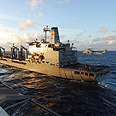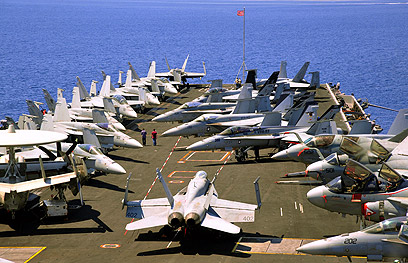
The rising tensions between the West and Iran, prompted by the latter's refusal to suspend its nuclear program, has prompted the United States to bolster its defenses in the Persian Gulf, the Wall Street Journal reported Tuesday.
The Islamic Republic has also threatened to close the Strait of Hormuz, through which 20% of the world's oil supply is shuttled.
Related stories:
- US ship fires on boat off Dubai, 1 dead
- Pentagon: US Navy will remain in Gulf
Iran: US presence in Gulf 'not new issue'
On Sunday, Saudi Arabia and the United Arab Emirates inaugurated new pipelines meant to bypass Hormuz and secure oil exports.
According to the WSJ, the Pentagon "is building a missile-defense radar station at a secret site in Qatar and organizing its biggest-ever minesweeping exercises in the Persian Gulf."
The radar, the report said, will "complete the backbone" of a US' defense system meant to safeguard US interests in the region, as well as protect European nations and Israel from long-range Iranian rockets.
The UN Navy's minesweeping exercises will be the first of its kind in the region.

Iranian maneuvers in the Strait of Hormuz (Photo: MCT)
Amid the growing tensions vis-à-vis Iran, Washington has also brought forward the deployment of an aircraft carrier to the Middle East to shorten the time when a sole carrier is in the region.
Pentagon Spokesman George Little told reporters on Monday that Defense Secretary Leon Panetta last week approved a request for the USS John-Stennis strike group to be deployed four months earlier than scheduled.
"It will now deploy in late summer. The decision will help support existing naval force requirements in the Middle East and will reduce the gap created by the planned upcoming departure of the Enterprise strike group," Little said.

The USS John-Stennis (Photo: AP)
There have been two aircraft carriers deployed in the region: The USS Abraham Lincoln and the USS Enterprise.
The Lincoln passed through the Suez Canal on Monday, leaving the Fifth Fleet's zone of responsibility en route back to the United States to complete its eight month deployment, the Pentagon said.
The Lincoln is to be replaced soon by the USS Dwight Eisenhower, which would have been left alone in the troubled Middle East region for several months had the US Navy not decided to accelerate the arrival of the Stennis.
The United States beefed up its presence in the strategic Gulf in December after Iran threatened to close the Strait of Hormuz if Western countries boycotted Iranian oil exports.
"It's no secret that the United States and our partners and our allies in the region face serious challenges, from a variety of sources," he said.
AFP and Yitzhak Benhorin, in Washington, contributed to this report
- Receive Ynetnews updates
directly to your desktop















